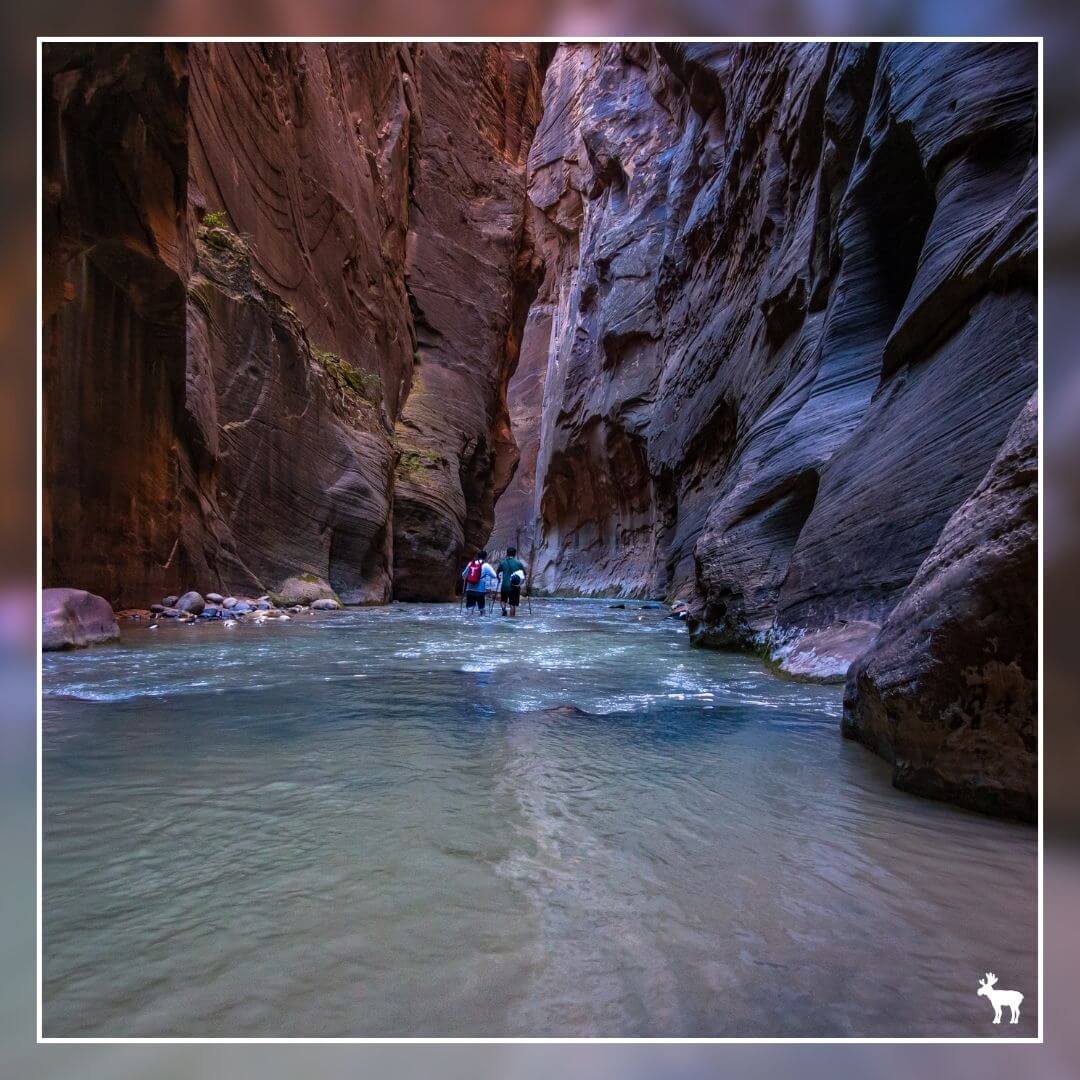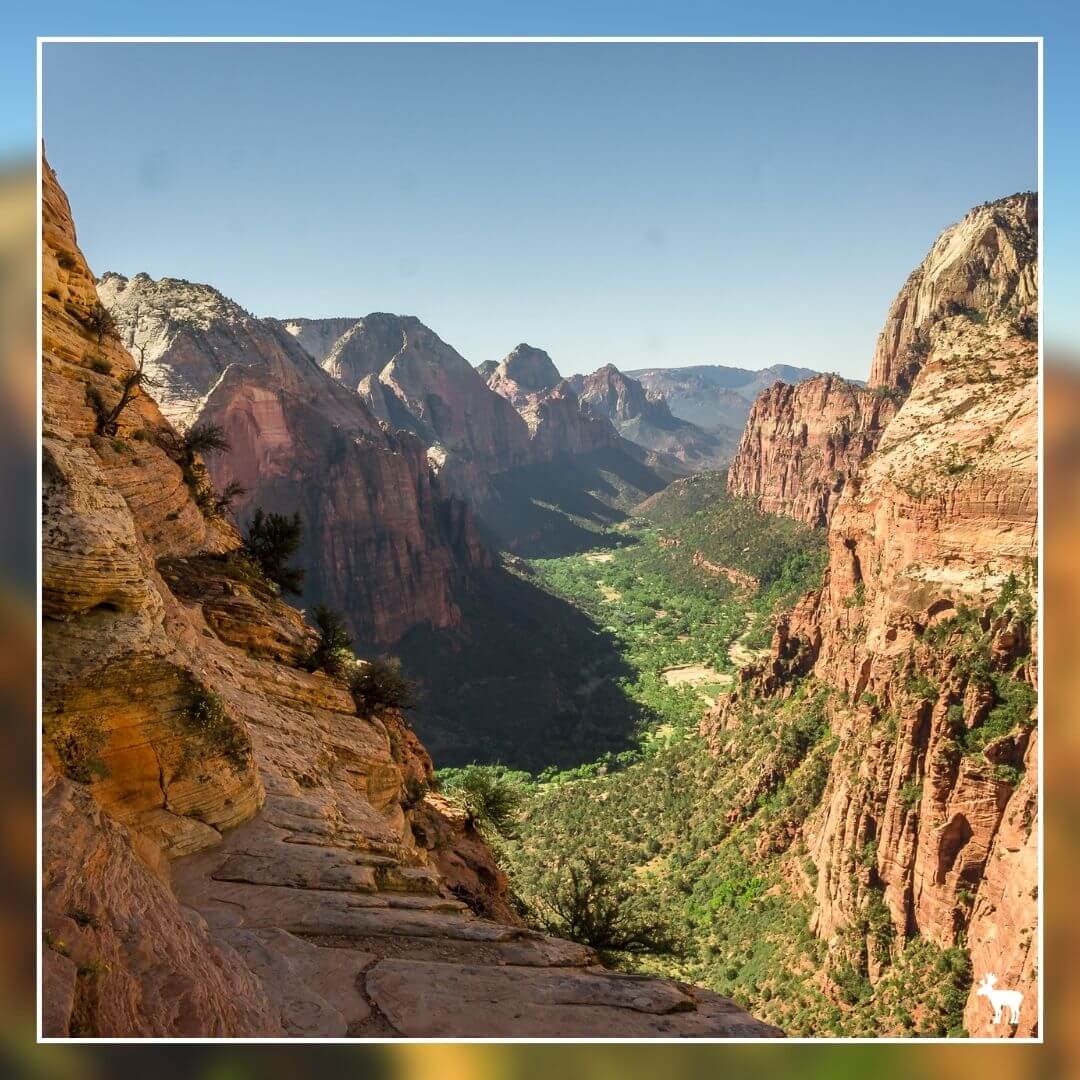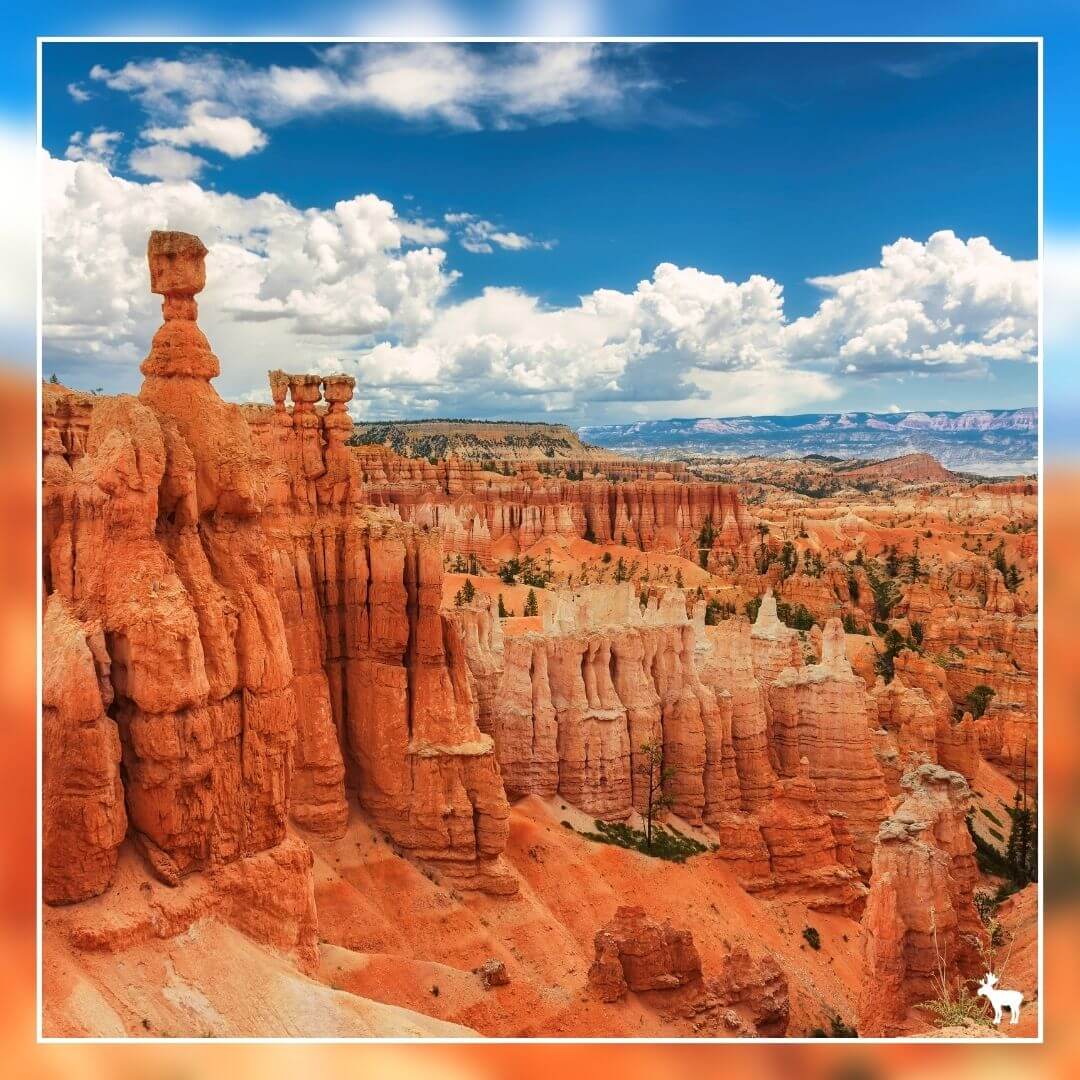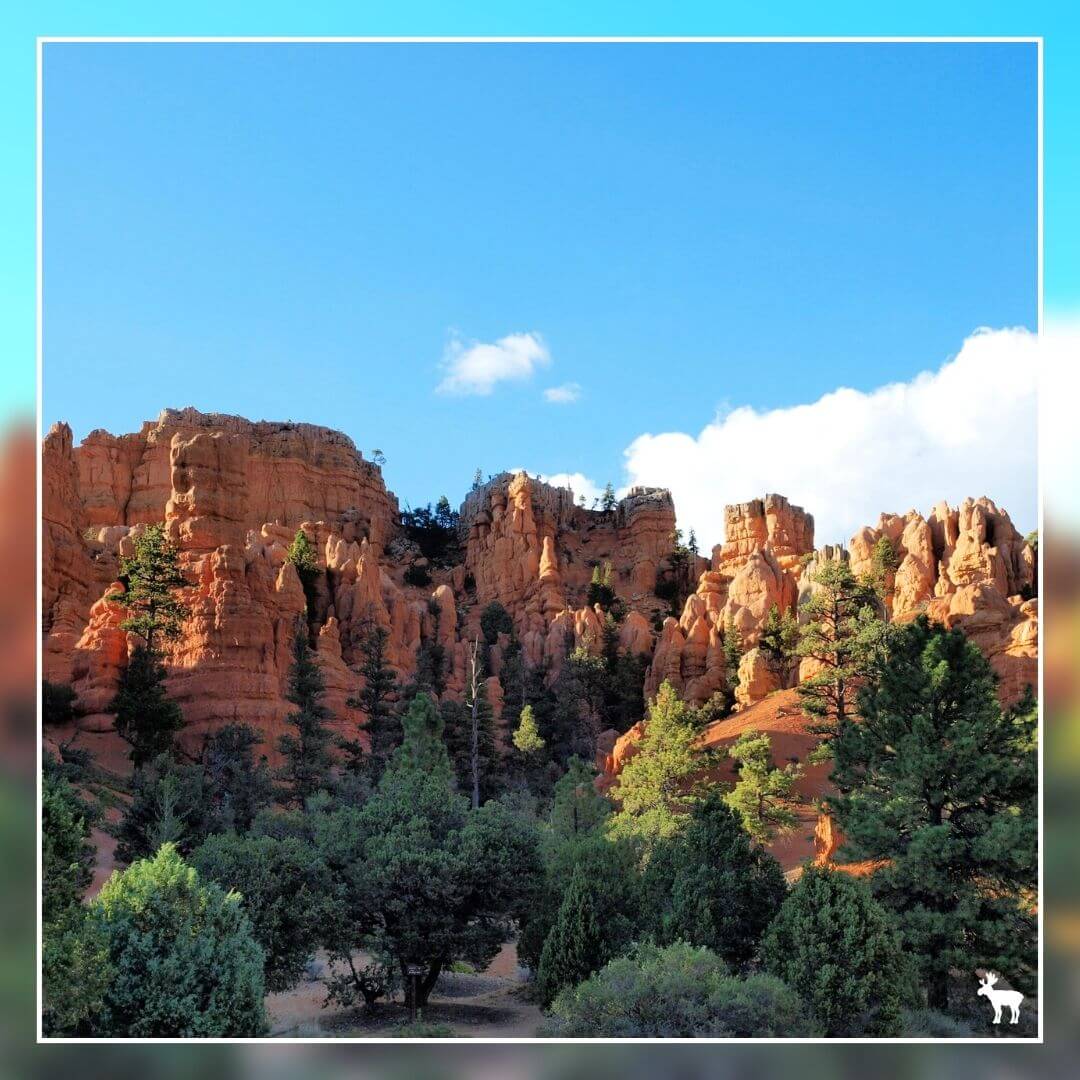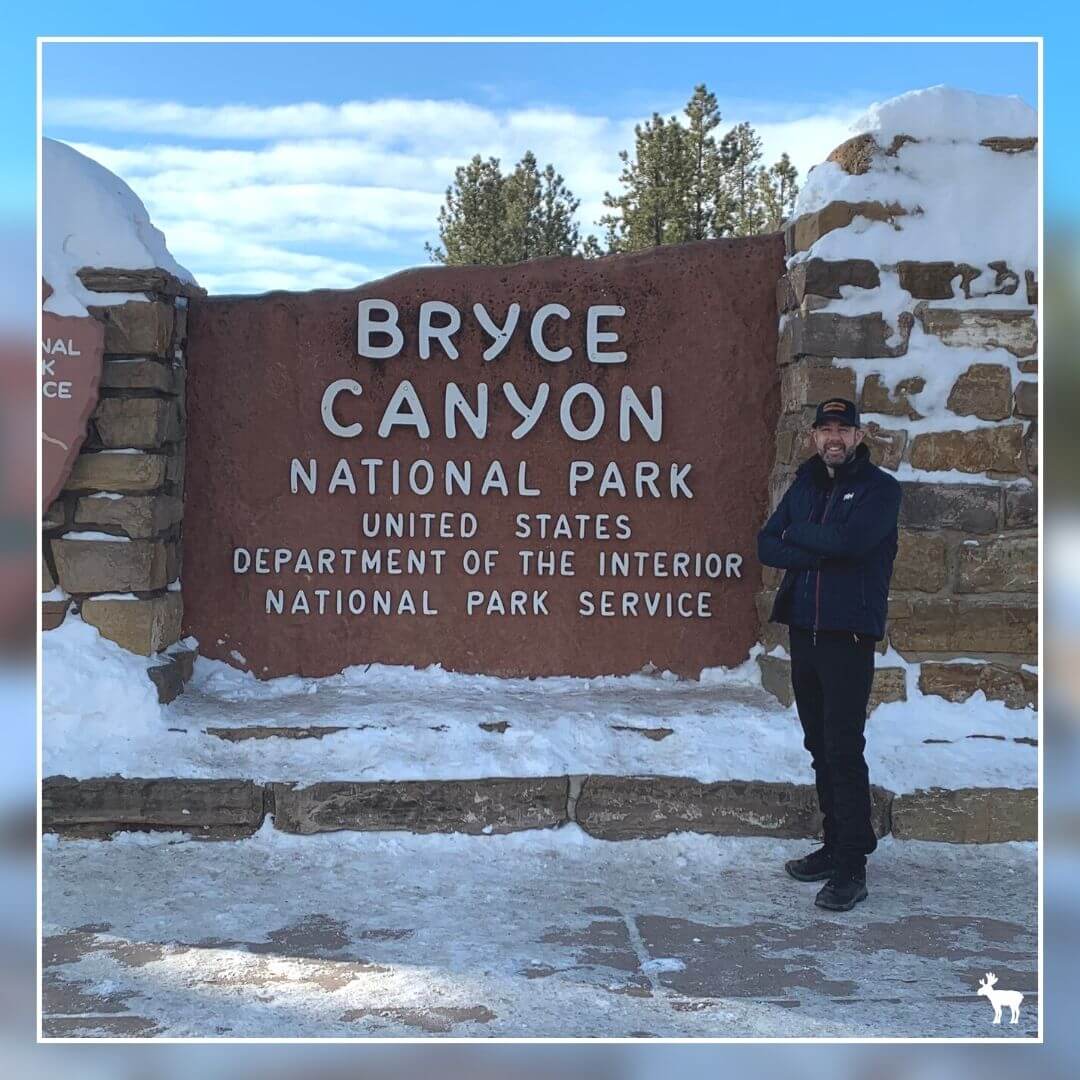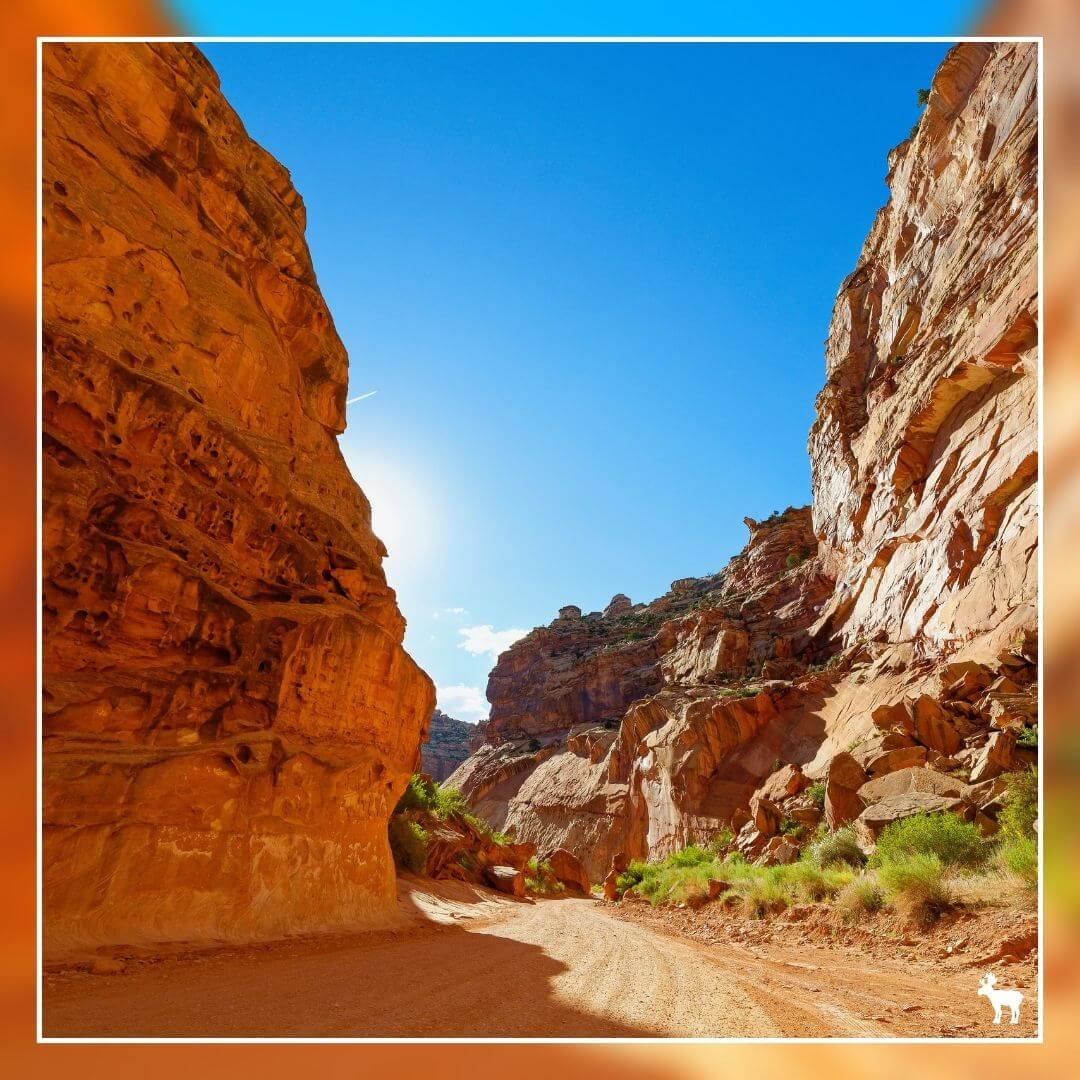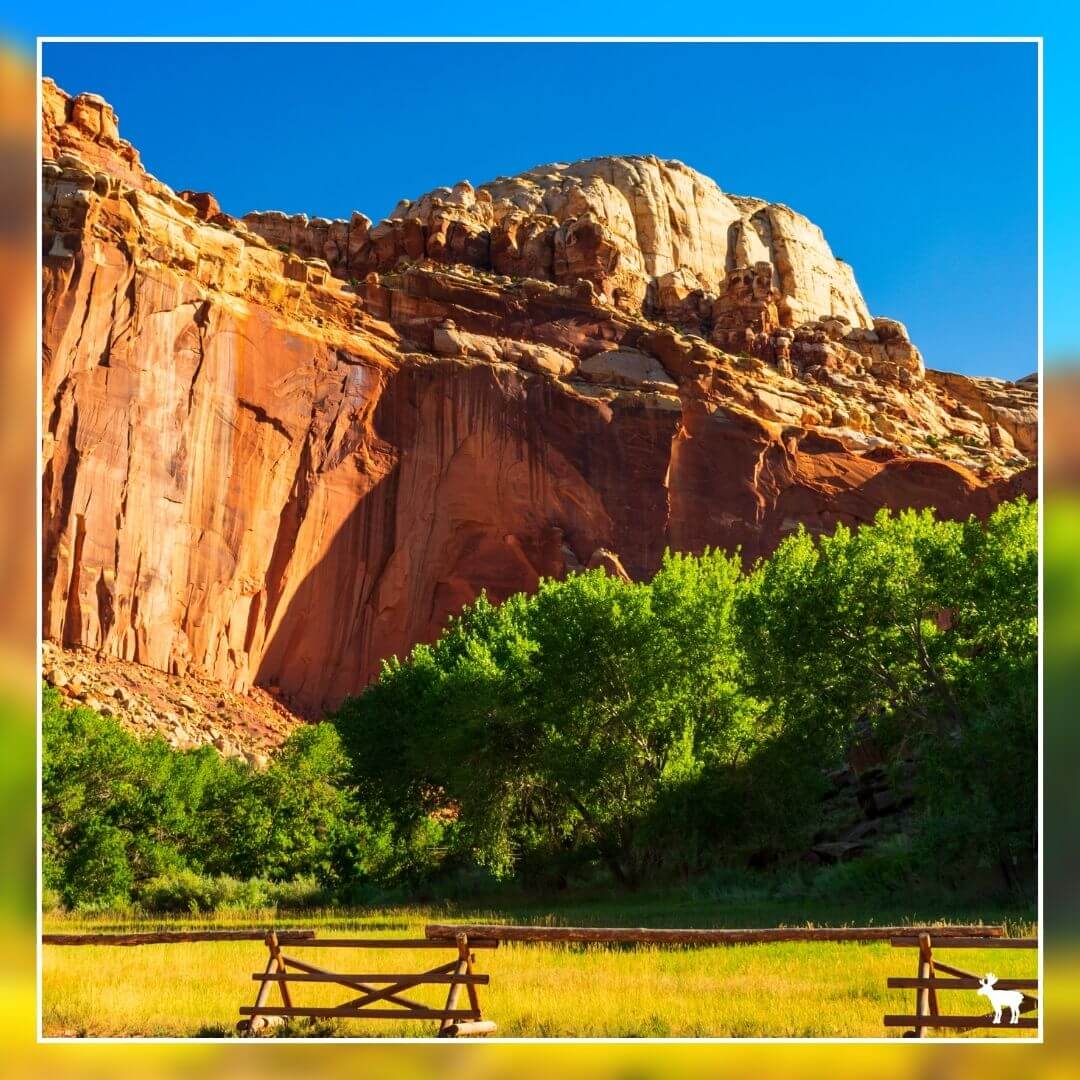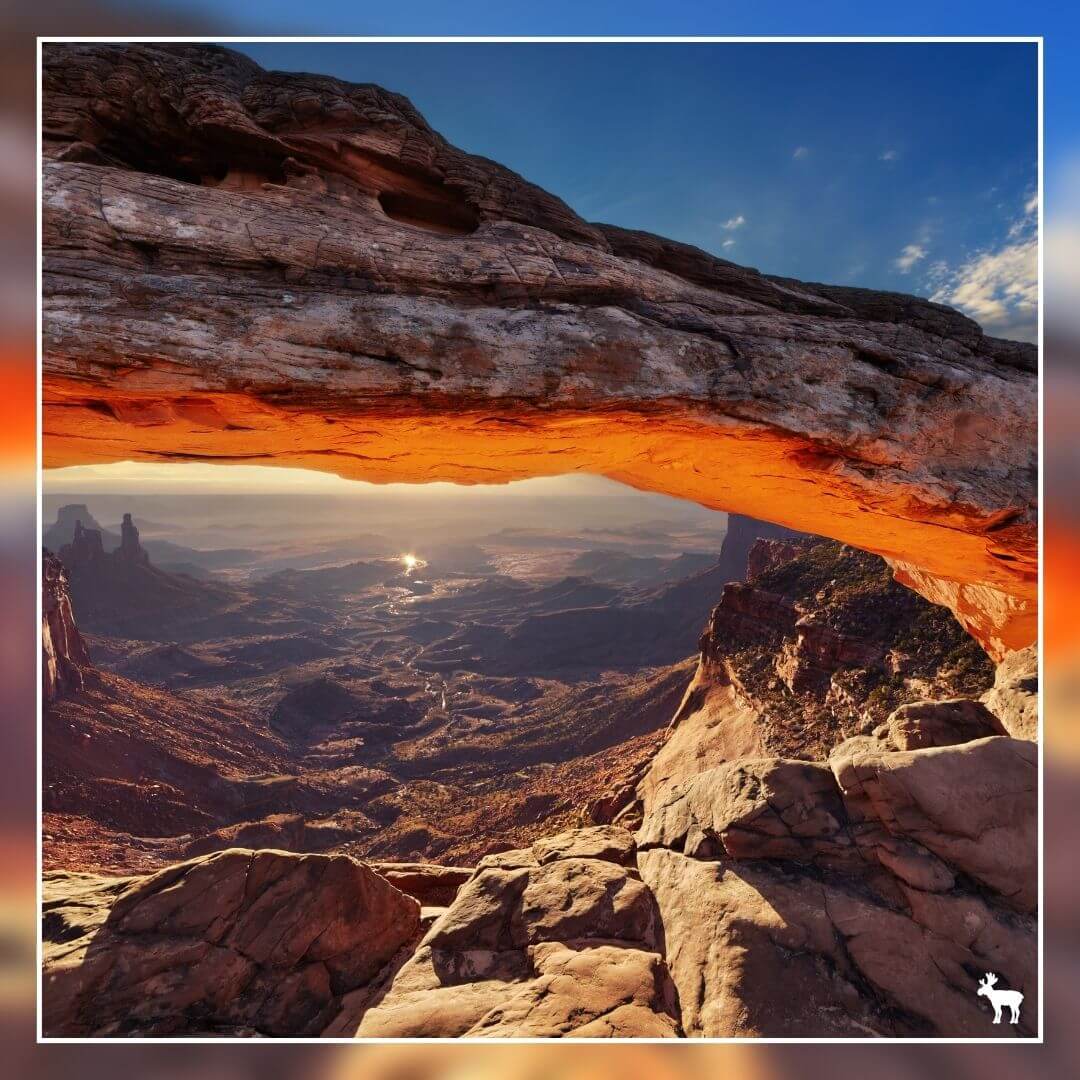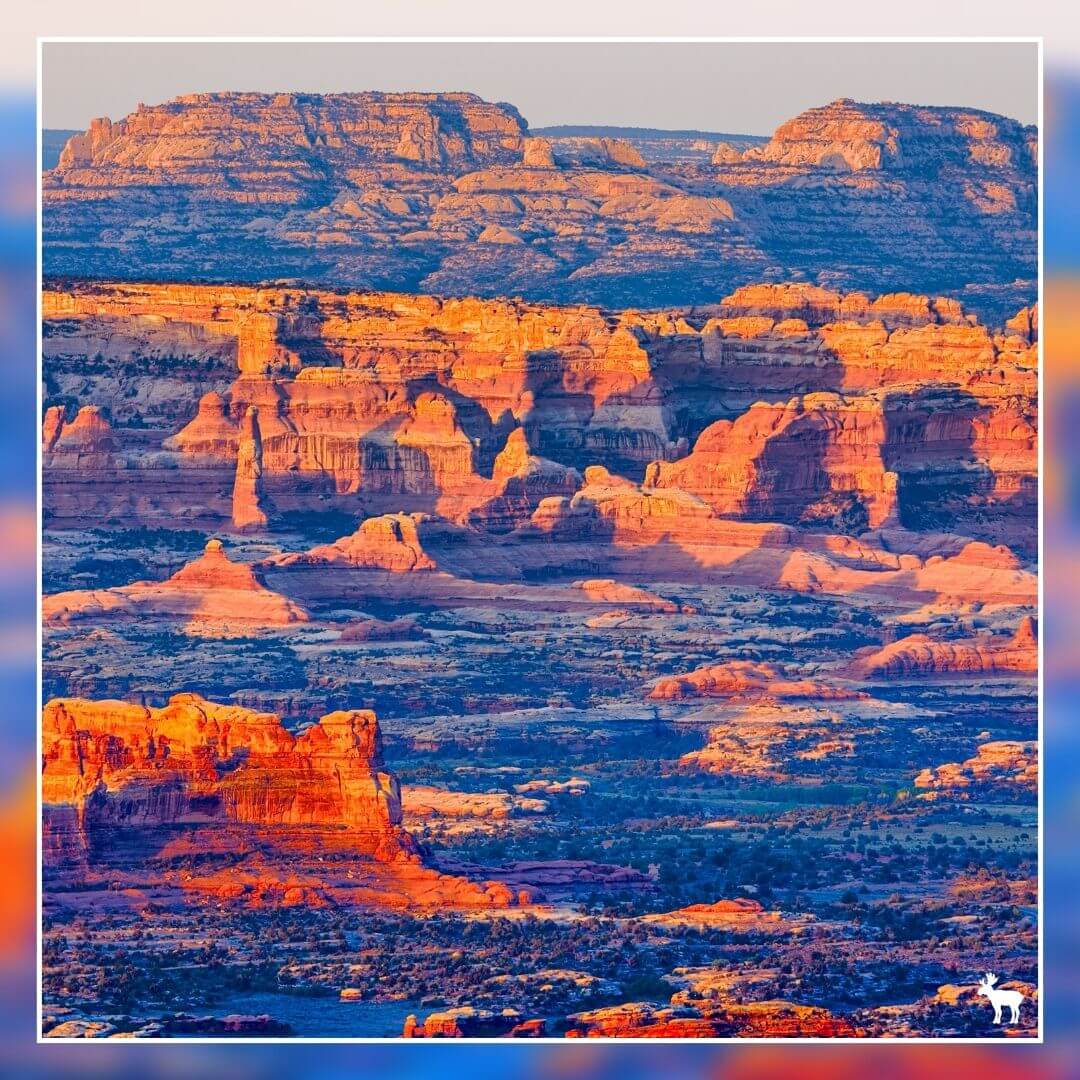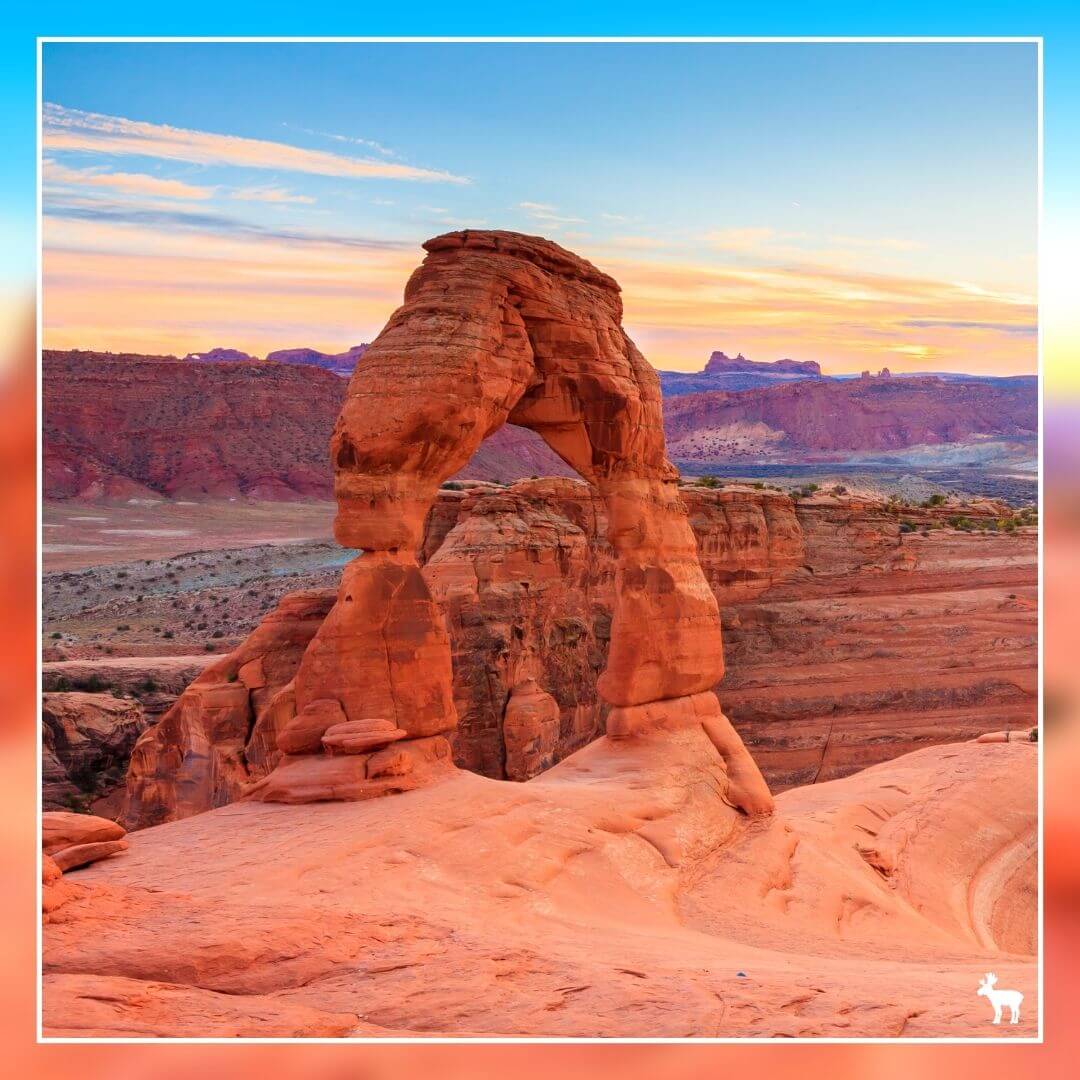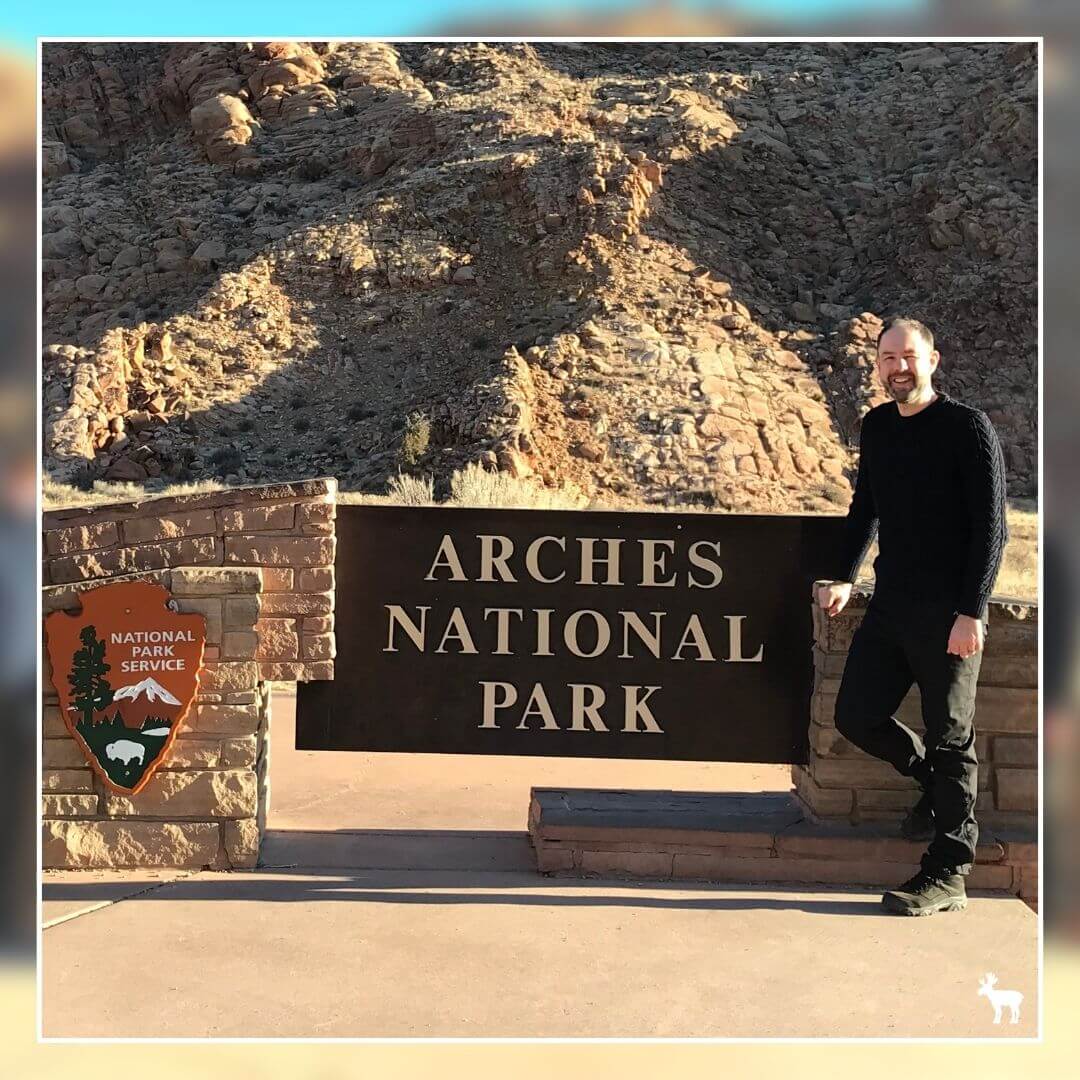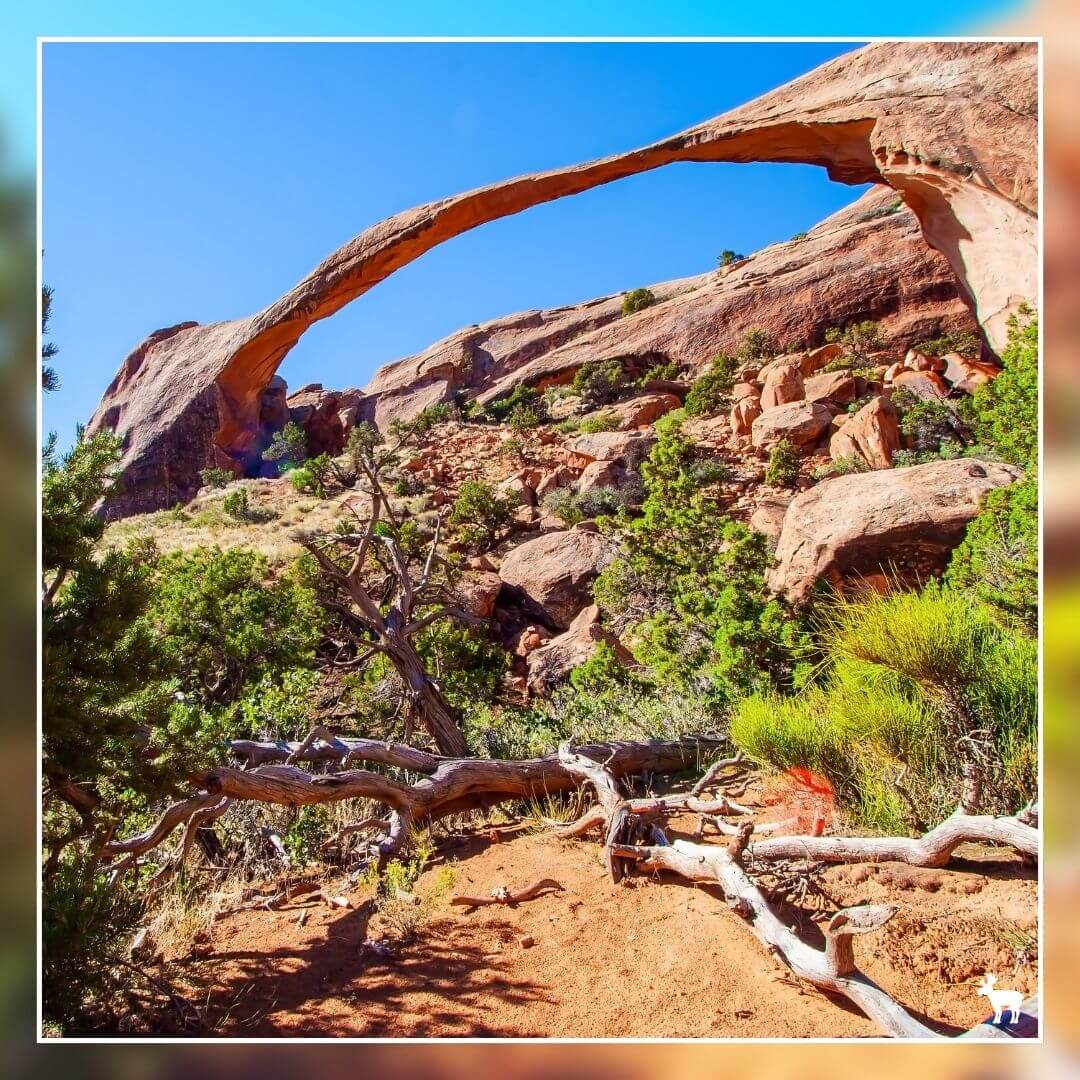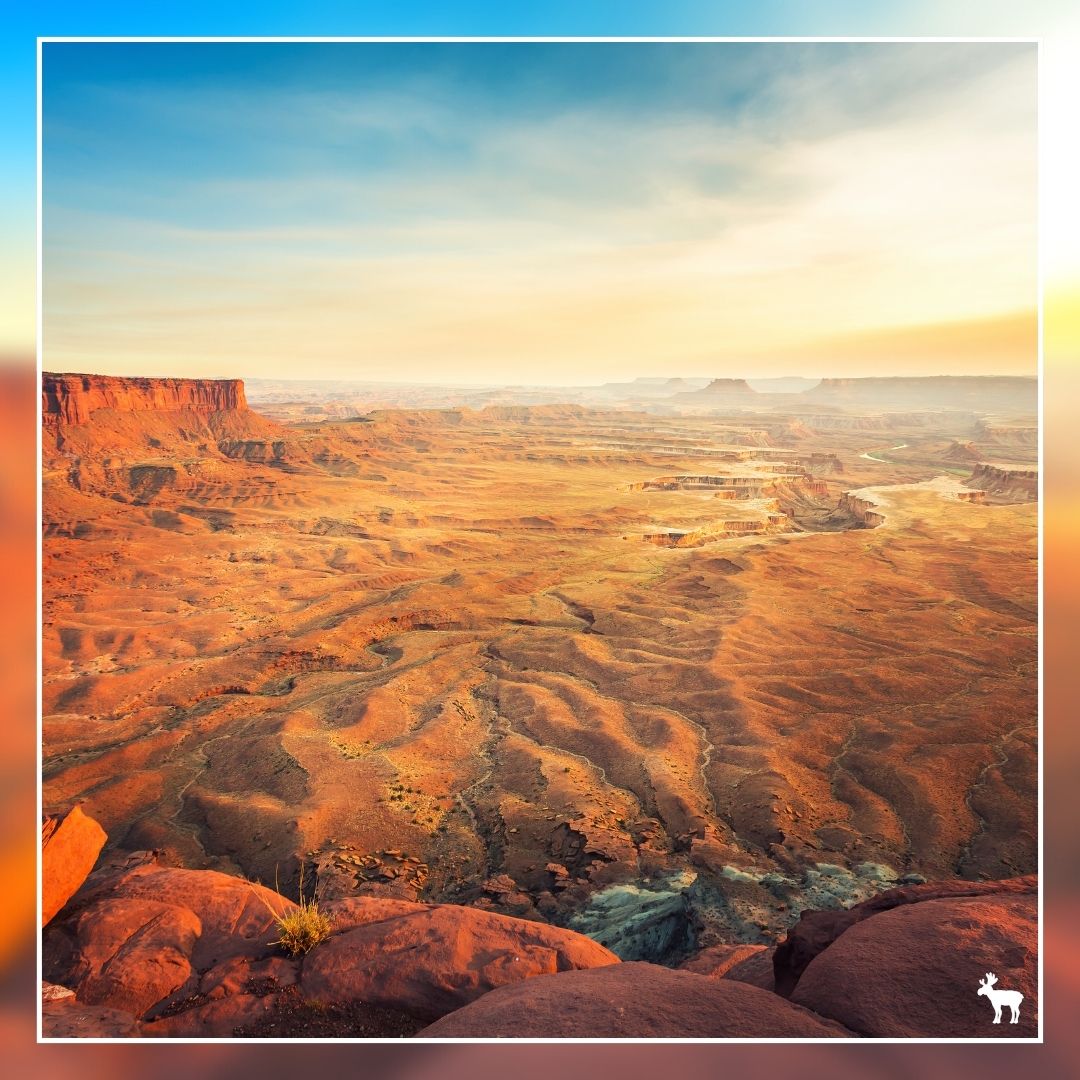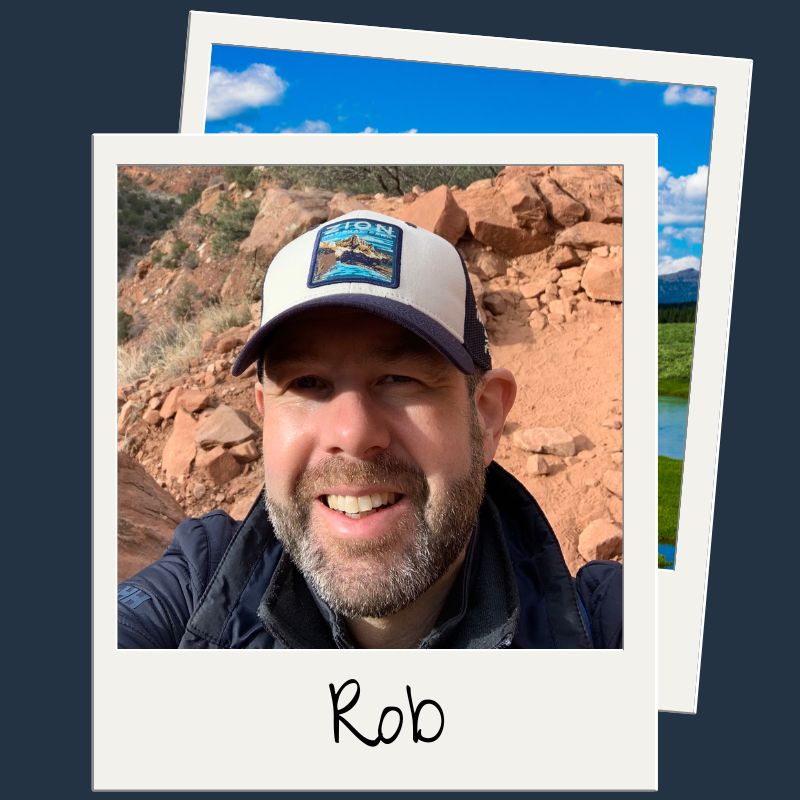Gear up for an unforgettable journey through Utah's Mighty 5 national parks with this easy-to-follow itinerary planner.
Designed for flexibility, you can cover this itinerary in just seven days. However, if time permits, why not extend your adventure? Adding a few extra days lets you explore more deeply, turning it into a 10-day adventure or even longer.
I highly recommend spending an additional day in Zion, Canyonlands, & Capitol Reef National Park, or consider an extension to Monument Valley. It's just a couple of hours' drive from Moab, your gateway to the arches and canyons, and adds a stunning addition to your adventure.
This planner is your ticket to an adventure that's as broad or as detailed as you like. So, pack your bags, and let's make some memories in Utah's natural playground.
Designed for flexibility, you can cover this itinerary in just seven days. However, if time permits, why not extend your adventure? Adding a few extra days lets you explore more deeply, turning it into a 10-day adventure or even longer.
I highly recommend spending an additional day in Zion, Canyonlands, & Capitol Reef National Park, or consider an extension to Monument Valley. It's just a couple of hours' drive from Moab, your gateway to the arches and canyons, and adds a stunning addition to your adventure.
This planner is your ticket to an adventure that's as broad or as detailed as you like. So, pack your bags, and let's make some memories in Utah's natural playground.
7 - 10 Day National Parks Road Trip Itinerary at a Glance
Days 1 & 2: Zion National Park
On your first day in Zion National Park, visit the Temple of Sinawava and take the Riverside Walk to Zion Canyon Narrows. Also, explore the Emerald Pools Trail, which leads to picturesque pools and waterfalls.
For more adventure, hike The Narrows along the Virgin River or tackle the Angels Landing Trail for breathtaking views.
Add an additional day at Zion National Park to make this into a 10 day itinerary.
For more adventure, hike The Narrows along the Virgin River or tackle the Angels Landing Trail for breathtaking views.
Add an additional day at Zion National Park to make this into a 10 day itinerary.
Day 3: Bryce Canyon National Park
During your Bryce Canyon National Park visit, take the 18-mile Bryce Canyon Scenic Drive to see various viewpoints of the colorful hoodoos.
Walk along the Rim Trail for more views and visit key spots like Inspiration Point for panoramic views, and Rainbow and Yovimpa Points for different perspectives of the canyon and beyond.
Walk along the Rim Trail for more views and visit key spots like Inspiration Point for panoramic views, and Rainbow and Yovimpa Points for different perspectives of the canyon and beyond.
Day 4: Capitol Reef National Park
Drive the scenic route, visit the Gifford Homestead, walk through historical orchards, and hike the Hickman Bridge Trail.
Explore the Grand Wash and Capitol Gorge roads, and if you're adventurous, consider a guided canyoneering tour through the park's rugged terrain.
Add an additional day at Capitol Reef National Park to make this into a 10 day itinerary.
Explore the Grand Wash and Capitol Gorge roads, and if you're adventurous, consider a guided canyoneering tour through the park's rugged terrain.
Add an additional day at Capitol Reef National Park to make this into a 10 day itinerary.
Day 5: Canyonlands National Park
Focus on the Island in the Sky district, the most accessible and popular area. A day is enough to see the overlooks and shorter trails here. Island in the Sky sits on a high mesa with dramatic drop-offs, offering the best view of the landscape below.
The key highlight is Grand View Point, providing spectacular views of canyons carved by the Colorado and Green Rivers.
Take a short walk to the Grand View Point Overlook for more stunning panoramic views
Add an additional day at Canyonlands National Park to make this into a 10 day itinerary.
The key highlight is Grand View Point, providing spectacular views of canyons carved by the Colorado and Green Rivers.
Take a short walk to the Grand View Point Overlook for more stunning panoramic views
Add an additional day at Canyonlands National Park to make this into a 10 day itinerary.
Days 6 & 7: Arches National Park
Enjoy a scenic drive showcasing famous natural arches and rock formations. Key attractions include the iconic Delicate Arch, viewed easily from two different spots, and Balanced Rock, with a short trail around its base.
For a more in-depth experience, explore the Park Avenue trail or the Devils Garden Loop, which includes the Landscape Arch and other unique formations.
For a more in-depth experience, explore the Park Avenue trail or the Devils Garden Loop, which includes the Landscape Arch and other unique formations.
How many days do you need to see Utah's national parks?
The time needed to visit Utah's national parks, often referred to as the "Mighty 5," can vary depending on your interests and pace. However, a general guideline is as follows:
How many days do you need in Zion National Park?
To fully enjoy Zion National Park, allocating two to three days is ideal. This timeframe lets you tackle longer hikes such as Angels Landing or the Narrows, while also visiting the main scenic spots.
If your schedule only permits a two-day visit, you can still experience several significant attractions along Zion Canyon. This includes doing shorter hikes like the Lower Emerald Pools and the Riverside Walk.
If your schedule only permits a two-day visit, you can still experience several significant attractions along Zion Canyon. This includes doing shorter hikes like the Lower Emerald Pools and the Riverside Walk.
How many days do you need in Bryce Canyon National Park?
Bryce Canyon National Park is known for being one of the more compact national parks, making it possible to see a lot in just one day or even half a day.
How many days do you need in Arches National Park?
Arches National Park is quite accessible and can be substantially explored in just a day, if that's your only option. However, an extra day in Arches is perfect for a more comprehensive experience. This would allow you to join the ranger-led hike through the Fiery Furnace and tackle some of the park's longer hiking trails.
The park's scenic drive provides numerous opportunities to see its famous natural arches and unique rock formations, with most trails being short and manageable, allowing for a couple of hikes in a short time.
The park's scenic drive provides numerous opportunities to see its famous natural arches and unique rock formations, with most trails being short and manageable, allowing for a couple of hikes in a short time.
How many days do you need in Canyonlands National Park?
For a visit focused on the Island in the Sky district in Canyonlands National Park, a single day is sufficient if you plan to stick to the main overlooks and shorter trails.
However, if you're interested in tackling the longer hiking trails or venturing on the off-road trails beneath the rim, planning for at least two days is advisable.
However, if you're interested in tackling the longer hiking trails or venturing on the off-road trails beneath the rim, planning for at least two days is advisable.
How many days do you need in Capitol Reef National Park?
Capitol Reef National Park's Fruita area is relatively small, allowing visitors to cover a lot of ground quickly. If your visit is limited to a single day, you can take a drive along the park's scenic route and explore the Grand Wash and Capitol Gorge spur roads. Within this timeframe, you'll also be able to visit the Gifford Homestead, stroll through the orchards, and enjoy a brief hike to Hickman Bridge.
In total, a trip covering all five parks would ideally be around 7-12 days. This allows for not just visiting the parks but also for travel time between them, as they are spread out across the state of Utah.
This Utah road trip itinerary does not include Monument Valley, Horseshoe Bend, Antelope Canyon, Lake Powell, or Grand Canyon National Park, but these destinations could be incorporated into a longer itinerary.
Additionally, Utah boasts some excellent state parks, such as Goblin Valley State Park and Dead Horse Point State Park, which are well worth visiting if you have more time in your itinerary.
In total, a trip covering all five parks would ideally be around 7-12 days. This allows for not just visiting the parks but also for travel time between them, as they are spread out across the state of Utah.
This Utah road trip itinerary does not include Monument Valley, Horseshoe Bend, Antelope Canyon, Lake Powell, or Grand Canyon National Park, but these destinations could be incorporated into a longer itinerary.
Additionally, Utah boasts some excellent state parks, such as Goblin Valley State Park and Dead Horse Point State Park, which are well worth visiting if you have more time in your itinerary.
Adventure Without the Effort
Embark on a Group Guided Tour with Everything Included
If you prefer not to plan your own trip, consider joining an organized group tour, where expert guides lead you on excursions, and all accommodations are included for a hassle-free experience.
How far apart are the 5 national parks in Utah?
The five national parks in Utah, known as the "Mighty 5," are spread out across the southern and eastern parts of the state. The distances between them vary, but here's a rough guide:
Zion to Bryce Canyon: About 72 miles (116 km), approximately a 1.5-hour drive.
Bryce Canyon to Capitol Reef: Roughly 120 miles (193 km), around a 2 to 2.5-hour drive.
Capitol Reef to Arches: Approximately 135 miles (217 km), which is about a 2 to 2.5-hour drive.
Arches to Canyonlands (Island in the Sky district): Only about 30 miles (48 km), around a 40-minute drive. It's important to note that Canyonlands has multiple districts, and the Island in the Sky district is the closest to Arches.
These distances make it feasible to drive between each park within a few hours, although the actual travel time can vary depending on road conditions, traffic, and stops along the way.
Zion to Bryce Canyon: About 72 miles (116 km), approximately a 1.5-hour drive.
Bryce Canyon to Capitol Reef: Roughly 120 miles (193 km), around a 2 to 2.5-hour drive.
Capitol Reef to Arches: Approximately 135 miles (217 km), which is about a 2 to 2.5-hour drive.
Arches to Canyonlands (Island in the Sky district): Only about 30 miles (48 km), around a 40-minute drive. It's important to note that Canyonlands has multiple districts, and the Island in the Sky district is the closest to Arches.
These distances make it feasible to drive between each park within a few hours, although the actual travel time can vary depending on road conditions, traffic, and stops along the way.
Where to start your 7 day itinerary in Utah’s national parks
You can embark on this Utah Mighty Five National Park itinerary from either direction, commencing in Moab to first explore Arches National Park and Canyonlands National Park, or beginning in Springdale to start with Zion National Park.
Starting from Moab, the nearest domestic and international airport is in Salt Lake City. The journey from Salt Lake City to Moab takes approximately four hours by car.
Alternatively, if you prefer to begin your adventure at Zion National Park, Las Vegas and St. George serve as convenient entry points to the greater Zion area.
Las Vegas is roughly 2 hours and 45 minutes by car from Springdale, the entrance to Zion National Park. The city's international airport provides numerous flights with major US and international airlines to destinations across the US, Canada, and Europe.
St. George, Utah, is a mere 50-minute drive from Springdale. Although smaller, St. George Airport has a selection of flights to US cities, including Dallas, Phoenix, Salt Lake City, Denver, and Los Angeles.
Car rental services are available at the airports in Salt Lake City, Las Vegas, and St. George, providing the flexibility to pick up a vehicle at one location and return it at another. This flexibility is perfect for travelers wishing to fly into Las Vegas or St. George, embark on the seven-day Utah National Parks road trip, and conclude their journey by dropping off their rental car in Salt Lake City before their departure flight.
Starting from Moab, the nearest domestic and international airport is in Salt Lake City. The journey from Salt Lake City to Moab takes approximately four hours by car.
Alternatively, if you prefer to begin your adventure at Zion National Park, Las Vegas and St. George serve as convenient entry points to the greater Zion area.
Las Vegas is roughly 2 hours and 45 minutes by car from Springdale, the entrance to Zion National Park. The city's international airport provides numerous flights with major US and international airlines to destinations across the US, Canada, and Europe.
St. George, Utah, is a mere 50-minute drive from Springdale. Although smaller, St. George Airport has a selection of flights to US cities, including Dallas, Phoenix, Salt Lake City, Denver, and Los Angeles.
Car rental services are available at the airports in Salt Lake City, Las Vegas, and St. George, providing the flexibility to pick up a vehicle at one location and return it at another. This flexibility is perfect for travelers wishing to fly into Las Vegas or St. George, embark on the seven-day Utah National Parks road trip, and conclude their journey by dropping off their rental car in Salt Lake City before their departure flight.
Days 1 & 2: Zion National Park
Due to the relatively short drive time between Las Vegas or St George and Springdale, it's beneficial to consider making this journey the night before you begin your Mighty 5 road trip.
This approach allows you to maximize your time in Zion National Park, as you can start exploring the park the next morning without the need for additional travel on your first day.
Keep in mind that the parking lots within the park tend to fill quickly throughout the day. Alternatively, parking is available in Springdale, where you can use the no-cost Springdale Line shuttle to reach the park entrance.
This approach allows you to maximize your time in Zion National Park, as you can start exploring the park the next morning without the need for additional travel on your first day.
Keep in mind that the parking lots within the park tend to fill quickly throughout the day. Alternatively, parking is available in Springdale, where you can use the no-cost Springdale Line shuttle to reach the park entrance.
The Zion Canyon Shuttle is the ideal method for navigating the park, connecting the Zion Canyon Visitor Center with various points of interest along the Zion Canyon Scenic Drive. Notable stops include Angels Landing, Emerald Pools, West Rim Trail, and the Narrows.
The trip from the Zion Canyon Visitor Center to the Temple of Sinawava lasts about 45 minutes, with a total round-trip duration of approximately 90 minutes.
Depending on when you get to Zion and what season it is, you'll have the chance to engage in different activities throughout your two-day stay in Zion National Park.
The Temple of Sinawava, an awe-inspiring natural amphitheater, signifies the beginning of Zion Canyon and can be reached at the final stop of the Zion Canyon Scenic Drive. It is also the starting location for the Riverside Walk.
The Riverside Walk is a one-mile paved path that follows the Virgin River to the mouth of the Zion Canyon Narrows. It includes several steep inclines and concludes at the point where the imposing Narrows gorge starts.
The Narrows, a 16-mile one-way hike, starts at the end of the Riverside Walk and is doable for casual hikers. This hike involves walking and wading through the Virgin River without a formal trail. Using a guide can enhance the experience, and with local outfitters, you can even hike these canyons in winter.
Angels Landing Trail: Ideal for those who are okay with heights and looking for a challenging hike, this 5.4-mile round trip ascends 1,488 feet to a stunning view of Zion Canyon. The last section of the trail is a narrow ridge with chains for added safety.
Emerald Pools Trail: This path leads to striking blue-green pools and waterfalls. It starts off paved to the Lower Emerald Pool and waterfalls, then becomes more uneven towards the Middle and Upper Emerald Pools. The hike can range from an easy 1.2 miles round trip to a longer 3 miles if exploring all the pools.
The trip from the Zion Canyon Visitor Center to the Temple of Sinawava lasts about 45 minutes, with a total round-trip duration of approximately 90 minutes.
Depending on when you get to Zion and what season it is, you'll have the chance to engage in different activities throughout your two-day stay in Zion National Park.
The Temple of Sinawava, an awe-inspiring natural amphitheater, signifies the beginning of Zion Canyon and can be reached at the final stop of the Zion Canyon Scenic Drive. It is also the starting location for the Riverside Walk.
The Riverside Walk is a one-mile paved path that follows the Virgin River to the mouth of the Zion Canyon Narrows. It includes several steep inclines and concludes at the point where the imposing Narrows gorge starts.
The Narrows, a 16-mile one-way hike, starts at the end of the Riverside Walk and is doable for casual hikers. This hike involves walking and wading through the Virgin River without a formal trail. Using a guide can enhance the experience, and with local outfitters, you can even hike these canyons in winter.
Angels Landing Trail: Ideal for those who are okay with heights and looking for a challenging hike, this 5.4-mile round trip ascends 1,488 feet to a stunning view of Zion Canyon. The last section of the trail is a narrow ridge with chains for added safety.
Emerald Pools Trail: This path leads to striking blue-green pools and waterfalls. It starts off paved to the Lower Emerald Pool and waterfalls, then becomes more uneven towards the Middle and Upper Emerald Pools. The hike can range from an easy 1.2 miles round trip to a longer 3 miles if exploring all the pools.
In the summer months, when the days are longer, you might consider traveling to Bryce Canyon after your second day at Zion National Park. This allows you to start early the next day at Bryce Canyon National Park.
The drive from Zion to Bryce Canyon takes about 1 and a half hours but you may want to allocate some extra time to stop at the viewpoints along the way to appreciate the vistas on National Scenic Byway (S.R. 9).
Add an additional day at Zion National Park to make this into a 10 day itinerary.
Day 3 Bryce Canyon National Park
Start at the visitor center to get a map and check the latest on road and trail conditions. Then head out on the Bryce Canyon Scenic Drive, an 18-mile route along the canyon's edge, offering access to multiple viewpoints with stunning views of the hoodoos below.
The Rim Trail connects these viewpoints, with several paths descending from the rim to the park's iconic rock formations.
Inspiration Point is considered the most stunning view in Bryce Canyon, providing a wide view of the Bryce Amphitheater and the Silent City's hoodoos. The Rim Trail links Inspiration Point to Bryce Point and Sunset Point.
At the scenic drive's end are Yovimpa Point and Rainbow Point, the highest overlooks in the park. Rainbow Point gives a view north of the Bryce Canyon amphitheater and the Grand Staircase-Escalante National Monument's rock layers. Yovimpa Point looks south towards the Grand Canyon's northern rim.
The Bryce Canyon Rim Trail, spanning 5.5 miles, follows the rim and connects all overlooks from Fairyland Point to Bryce Point, offering breathtaking views along its length.
There are several good accommodation options just outside Bryce Canyon National Park.
Places to stay near Capitol Reef National Park
Capitol Reef Resort
|
Skyview Hotel
|
Adventure Without the Effort
Embark on a Group Guided Tour with Everything Included
If you prefer not to plan your own trip, consider joining an organized group tour, where expert guides lead you on excursions, and all accommodations are included for a hassle-free experience.
Day 4 Capitol Reef National Park
This morning calls for an early start, as you have a little over a two-hour drive from Bryce Canyon to the visitor center at Capitol Reef National Park (unless you opted to make the journey the night before).
Be sure to take the park’s scenic drive, including detours on the Grand Wash and Capitol Gorge spur roads. In a day, you can also visit the Gifford Homestead, wander through the historic orchards nearby, and take the short hike to Hickman Bridge.
The orchards near the visitor center are a testament to the Fruita pioneer community, dating back to 1880, and are home to a variety of historic fruit trees.
The Hickman Bridge Trail, a one-mile walk from the parking lot, leads to the striking natural arch of Hickman Bridge, meandering by the Fremont River before climbing the Waterpocket Fold's lower slopes.
The Capitol Reef Scenic Drive is 7.9 miles of paved road through the heart of the park, beginning at the visitor center and offering access to several hiking trailheads. The dirt road of Grand Wash guides you to Cassidy Arch trailhead and through the captivating canyon of Grand Wash.
After the scenic drive's pavement ends, a two-mile dirt path extends into Capitol Gorge, a historic route through Utah, winding through a slender canyon. At its conclusion, a trail follows the old roadbed to the Pioneer Registry, where early travelers etched their names into the rocks.
For those seeking adventure, try a guided canyoneering trip. Canyoneering combines ropework and climbing to navigate canyons, offering an exhilarating way to see Capitol Reef's wild landscapes. Various local companies provide tours suitable for different skill levels.
Exiting Capitol Reef Park towards Hanksville, Utah, you'll find limited places to stay. It's advisable to head to Moab for a broader selection of accommodations, positioning you perfectly to explore Canyonlands National Park the next day.
The journey from Hanksville to Moab, via Green River, takes about 1 hour and 45 minutes.
Add an additional day at Capitol Reef National Park to make this into a 10 day itinerary.
Day 5 Canyonlands National Park
Canyonlands National Park is divided into three unique sections: Island in the Sky, the Needles, and the Maze, with Island in the Sky being the most accessible and a 40-minute drive from Moab.
A day is enough to visit the overlooks and tackle the shorter hikes in the Island in the Sky area of Canyonlands National Park.
A day is enough to visit the overlooks and tackle the shorter hikes in the Island in the Sky area of Canyonlands National Park.
Located on a vast mesa edged by steep cliffs, Island in the Sky seems to hover above the Colorado River, earning its name from its appearance of floating above the surrounding landscape, linked to the Colorado Plateau by a narrow landform called "The Neck."
A key highlight of Island in the Sky is Grand View Point, considered the park's premier vista. At the road's end, it unveils a stunning vista of canyons carved by the Colorado and Green Rivers, with White Rim Road winding below along the canyon floor.
To get a closer look at Grand View Point, a one-mile walk takes you to the Grand View Point Overlook, offering expansive views from the mesa's edge to the viewpoint at its southern end.
Sunrise at Mesa Arch in Canyonlands National Park
Mesa Arch is a spectacle at any hour, but sunrise brings a special magic. As the early morning sun hits the arch, it casts a fiery red glow, creating a stunning frame for the rising sun. Arriving well before sunrise is essential to secure a good viewing spot.
Ranger-Led Stargazing Program in Arches & Canyonlands National Parks
Both Arches and Canyonlands have been designated as official International Dark Sky Parks, offering some of the darkest and most pristine skies in the country.
Throughout the summer, rangers conduct stargazing programs in both parks. Alternatively, you can use a night sky app for a self-guided stargazing experience.
Add an additional day at Canyonlands National Park to make this into a 10 day itinerary.
Days 6 & 7: Arches National Park
Arches National Park, just 5 miles north of Moab off Highway 191, might just be one of the best national parks and the highlight of the trip.
The park offers a scenic drive with stunning views of its famous natural arches and fascinating rock formations, and most hikes here are short.
The park offers a scenic drive with stunning views of its famous natural arches and fascinating rock formations, and most hikes here are short.
The Arches Scenic Drive is a great way to see the park's most impressive arches and landscapes. While many sights are visible from your car, I highly recommend getting out to explore on foot. There's a range of short hikes, from easy walks to overlooks to more extensive treks past several arches.
Delicate Arch is the park's most iconic feature, symbolizing Utah on license plates and welcome signs. The Lower Delicate Arch Viewpoint is easy to reach from its parking area. For a closer look, the 0.5-mile hike to the Upper Delicate Arch Viewpoint is worth the effort.
Balanced Rock, seeming like it might fall at any moment, towers at 128 feet tall. You can see it from the road, but a short 0.3-mile loop allows for a closer examination.
The Spectacles, two nearly circular arches standing side by side, can be reached via an easy 1-mile round-trip hike that includes the North Window, South Window, and Turret Arch. This trail starts at the Park Avenue parking area and goes down into a canyon lined with huge rock formations.
With two days at Arches National Park, you have plenty of time for a deeper exploration on your last day.
The full Devils Garden Loop is 8 miles long and features several arches, including Landscape Arch, North America's longest arch, and Double O Arch. You don’t have to do the whole loop; shorter hikes to Landscape Arch or a casual walk to Pine Tree Arch are also rewarding.
Dead Horse Point State Park is just 40 minutes from the Arches visitor center. The views here often impress visitors more than those of the Grand Canyon.
Moab is renowned for mountain biking, with many trails just 10-20 minutes from either Arches or downtown Moab. The famous Slickrock Trail in Sand Flats is a great place to start.
Monument Valley extension
If you have time on your side, then I'd highly recommend adding an extension to Monument Valley after visiting Moab. Although it's not one of Utah's Mighty Five national parks, it's certainly worth the visit.
Options for staying in Monument Valley are few, but I opted for Goulding's Lodge↗ for an overnight stay.
The rooms had amazing views of Monument Valley, and I also pre-booked a guided tour of the valley↗ with a Navajo guide. The tour was an excellent way to learn about Monument Valley, see the rock formations from the best viewpoints, and we also visited a Navajo reservation.
Though it's possible to drive through the valley on your own in private vehicles, I'd strongly suggest the guided tour for a more enriched experience.
Goulding's Lodge
|
|
Adventure Without the Effort
Embark on a Group Guided Tour with Everything Included
If you prefer not to plan your own trip, consider joining an organized group tour, where expert guides lead you on excursions, and all accommodations are included for a hassle-free experience.
Field Notes & Mooseful Information
When is the best time to visit Arches National Park?
The ideal times to visit Arches National Park are during the shoulder seasons of April to May and September to October when the weather is most favorable for exploring. Although the park experiences its highest visitor traffic from March to October, especially on weekends and holidays like Easter, Memorial Day, and Labor Day, purchasing a park pass online before your visit can help avoid long lines.
To minimize encounters with crowds, aim to visit early in the morning or late in the afternoon. The park is implementing measures to manage congestion and parking challenges, including timed entry tickets, so it's wise to consult the park's official website for the most current information.
Winter also presents a unique opportunity to enjoy the park with fewer visitors, though snow is possible, so always verify the latest weather conditions through the park's website or at the visitor center before your trip.
To minimize encounters with crowds, aim to visit early in the morning or late in the afternoon. The park is implementing measures to manage congestion and parking challenges, including timed entry tickets, so it's wise to consult the park's official website for the most current information.
Winter also presents a unique opportunity to enjoy the park with fewer visitors, though snow is possible, so always verify the latest weather conditions through the park's website or at the visitor center before your trip.
When is the best time to visit Bryce Canyon National Park?
Bryce Canyon National Park welcomes visitors all year round. To avoid the crowds and enjoy more solitude, the best times for a visit are early morning or late afternoon, particularly from early spring through October, which marks the park's peak season. Purchasing your park pass online in advance can also help expedite your entry.
The months of June and July see the highest number of visitors. While summer days in Bryce Canyon are generally pleasant, they are often punctuated by afternoon thunderstorms and flash floods. September offers weather conditions similar to June but with an increased likelihood of storms.
From October to May, temperatures drop significantly, with the coldest months being December through February. Although winter brings fewer visitors and lower accommodation rates, it also offers sunny days with the landscape beautifully enhanced by snow.
Regardless of when you plan to visit, it's crucial to check the latest weather forecast on the National Parks Service website or at the park's visitor center before your trip.
The months of June and July see the highest number of visitors. While summer days in Bryce Canyon are generally pleasant, they are often punctuated by afternoon thunderstorms and flash floods. September offers weather conditions similar to June but with an increased likelihood of storms.
From October to May, temperatures drop significantly, with the coldest months being December through February. Although winter brings fewer visitors and lower accommodation rates, it also offers sunny days with the landscape beautifully enhanced by snow.
Regardless of when you plan to visit, it's crucial to check the latest weather forecast on the National Parks Service website or at the park's visitor center before your trip.
When is the best time to visit Zion National Park?
Spring and fall when the weather is mild is a great time to visit Zion National Park.
The park is open all year but gets very crowded from April to September, especially during weekends and holidays. Buying your pass online can save time.
Summers are hot and require using a shuttle bus to get around inside the park. Early mornings or late afternoons are cooler. Weather changes with elevation; winter months are snowy with fewer crowds, offering cheaper hotel rates. It's always a good idea to check the weather before you go.
The park is open all year but gets very crowded from April to September, especially during weekends and holidays. Buying your pass online can save time.
Summers are hot and require using a shuttle bus to get around inside the park. Early mornings or late afternoons are cooler. Weather changes with elevation; winter months are snowy with fewer crowds, offering cheaper hotel rates. It's always a good idea to check the weather before you go.
When is the best time to visit Canyonlands National Park?
The best time to visit Canyonlands National Park is during the milder seasons of spring and fall, when the weather is most pleasant for outdoor activities. The park is open year-round, 24/7, but it sees the most visitors from March to October, particularly on holidays and weekends. To dodge the crowds, consider arriving early in the day.
Weather conditions can greatly vary: spring and fall offer mild temperatures, summer brings intense heat, and winter can be cooler with occasional snowfall. It's important to always check the latest weather updates on the National Parks Service website or at the visitor center before heading out to the park.
Weather conditions can greatly vary: spring and fall offer mild temperatures, summer brings intense heat, and winter can be cooler with occasional snowfall. It's important to always check the latest weather updates on the National Parks Service website or at the visitor center before heading out to the park.
In summary
Days 1 & 2
For Days 1 & 2 at Zion National Park, consider arriving from Las Vegas or St George the night before to begin exploring Zion early the next day.
Utilize the free Springdale Line shuttle for park access, as parking fills up quickly. The Zion Canyon Shuttle connects you to major sights like Angels Landing, Emerald Pools, West Rim Trail, and the Narrows, with a round trip to the Temple of Sinawava taking about 90 minutes.
Activities vary by season, including the Riverside Walk and the Narrows hike, suitable for casual hikers. Angels Landing offers a challenging hike with rewarding views, while the Emerald Pools Trail leads to beautiful pools and waterfalls.
Consider moving to Bryce Canyon after your second day in Zion, allowing for an early start there after a 1.5-hour drive, possibly with stops along S.R. 9 for scenic views.
Utilize the free Springdale Line shuttle for park access, as parking fills up quickly. The Zion Canyon Shuttle connects you to major sights like Angels Landing, Emerald Pools, West Rim Trail, and the Narrows, with a round trip to the Temple of Sinawava taking about 90 minutes.
Activities vary by season, including the Riverside Walk and the Narrows hike, suitable for casual hikers. Angels Landing offers a challenging hike with rewarding views, while the Emerald Pools Trail leads to beautiful pools and waterfalls.
Consider moving to Bryce Canyon after your second day in Zion, allowing for an early start there after a 1.5-hour drive, possibly with stops along S.R. 9 for scenic views.
Day 3
On Day 3 at Bryce Canyon National Park, start with a visit to the visitor center for maps and condition updates.
Explore the park via the 18-mile Bryce Canyon Scenic Drive, which provides stunning views of the hoodoos from various viewpoints connected by the Rim Trail. Key viewpoints include Inspiration Point, offering expansive views of the Bryce Amphitheater, and the trail also links to Bryce Point and Sunset Point.
The drive concludes at Yovimpa and Rainbow Points, the highest overlooks with views towards the Grand Staircase-Escalante and the northern rim of the Grand Canyon.
Accommodation options are available just outside the park.
Explore the park via the 18-mile Bryce Canyon Scenic Drive, which provides stunning views of the hoodoos from various viewpoints connected by the Rim Trail. Key viewpoints include Inspiration Point, offering expansive views of the Bryce Amphitheater, and the trail also links to Bryce Point and Sunset Point.
The drive concludes at Yovimpa and Rainbow Points, the highest overlooks with views towards the Grand Staircase-Escalante and the northern rim of the Grand Canyon.
Accommodation options are available just outside the park.
Day 4
Day 4 at Capitol Reef National Park starts with an early drive from Bryce Canyon to the visitor center.
Explore the scenic drive, visit Gifford Homestead, historic orchards, and hike to Hickman Bridge.
Don't miss the Capitol Reef Scenic Drive, Grand Wash, and Capitol Gorge. Consider a canyoneering tour for adventure. Accommodations are limited, so head to Moab for more options and to prepare for your visit to Canyonlands National Park the next day.
Explore the scenic drive, visit Gifford Homestead, historic orchards, and hike to Hickman Bridge.
Don't miss the Capitol Reef Scenic Drive, Grand Wash, and Capitol Gorge. Consider a canyoneering tour for adventure. Accommodations are limited, so head to Moab for more options and to prepare for your visit to Canyonlands National Park the next day.
Day 5
On Day 5 at Canyonlands National Park, you'll explore the Island in the Sky section, which is the most accessible and a 40-minute drive from Moab. This area features breathtaking overlooks and shorter hikes. Island in the Sky is perched on a mesa above the Colorado River and offers incredible views.
Grand View Point is a must-see, providing a premier vista of the Colorado and Green Rivers' canyons. You can take a one-mile walk to the Grand View Point Overlook for a closer look.
Mesa Arch is another highlight, especially at sunrise when it creates a stunning frame for the rising sun. Arrive early to secure a good spot.
Additionally, both Arches and Canyonlands National Parks offer ranger-led stargazing programs, as they are designated International Dark Sky Parks with pristine night skies.
Grand View Point is a must-see, providing a premier vista of the Colorado and Green Rivers' canyons. You can take a one-mile walk to the Grand View Point Overlook for a closer look.
Mesa Arch is another highlight, especially at sunrise when it creates a stunning frame for the rising sun. Arrive early to secure a good spot.
Additionally, both Arches and Canyonlands National Parks offer ranger-led stargazing programs, as they are designated International Dark Sky Parks with pristine night skies.
Days 6 & 7
Days 6 & 7 at Arches National Park offer an unforgettable experience. Located just 5 miles north of Moab off Highway 191, the park boasts stunning natural arches and rock formations. The Arches Scenic Drive provides great views, but it's essential to explore on foot.
Delicate Arch, an iconic feature of the park, is accessible via a 0.5-mile hike to the Upper Delicate Arch Viewpoint. Balanced Rock and The Spectacles are easily seen from the road, with short walks for closer views. The Devils Garden Loop, an 8-mile trail, reveals several arches, including Landscape Arch and Double O Arch.
For a deeper exploration on your second day, consider the 13-kilometer Devils Garden trail or a visit to the challenging Fiery Furnace, requiring permits or a guide.
Dead Horse Point State Park, just 40 minutes away, offers breathtaking views.
Moab is known for mountain biking, with trails close to Arches and downtown Moab. Slickrock Trail in Sand Flats is a popular starting point.
Delicate Arch, an iconic feature of the park, is accessible via a 0.5-mile hike to the Upper Delicate Arch Viewpoint. Balanced Rock and The Spectacles are easily seen from the road, with short walks for closer views. The Devils Garden Loop, an 8-mile trail, reveals several arches, including Landscape Arch and Double O Arch.
For a deeper exploration on your second day, consider the 13-kilometer Devils Garden trail or a visit to the challenging Fiery Furnace, requiring permits or a guide.
Dead Horse Point State Park, just 40 minutes away, offers breathtaking views.
Moab is known for mountain biking, with trails close to Arches and downtown Moab. Slickrock Trail in Sand Flats is a popular starting point.
|
Rob is an experienced independent travel consultant and travel content creator.
His love for travel started as a child, playing travel agent with his grandparents using holiday brochures from the local travel agency. Fast forward over 40 years, and Rob has turned this passion into a career, dedicating his time to helping others plan their dream vacations. He says his happy place is in a cozy cabin by a lake in Oregon, sitting at the bar of a honky-tonk on Broadway in Nashville, or closer to home walking and cycling in the Peak District National Park. |

